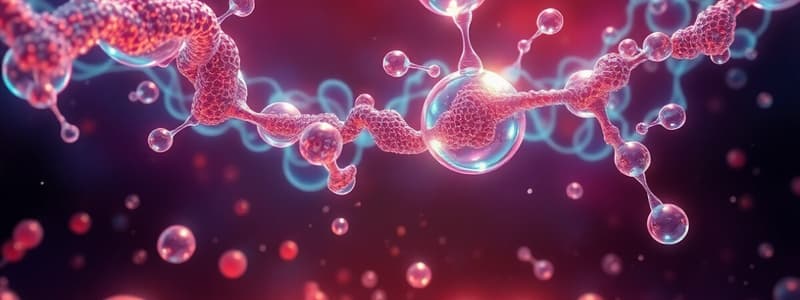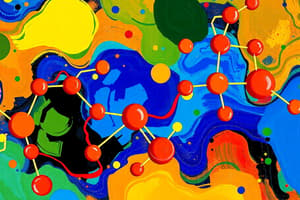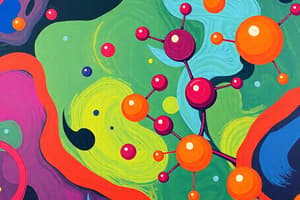Podcast
Questions and Answers
Which statement accurately describes the solubility characteristics of lipids?
Which statement accurately describes the solubility characteristics of lipids?
- Lipids are soluble in both water and non-polar solvents.
- Lipids are insoluble in water and soluble in non-polar solvents. (correct)
- Lipids are soluble in water and insoluble in non-polar solvents.
- Lipids are insoluble in both water and non-polar solvents.
What is one of the primary roles of lipids in living organisms?
What is one of the primary roles of lipids in living organisms?
- Generating hormones exclusively.
- Enhancing the solubility of nutrients in water.
- Insulating material for thermal regulation. (correct)
- Providing immediate energy.
Which type of lipid is formed from the esterification of fatty acids with glycerol?
Which type of lipid is formed from the esterification of fatty acids with glycerol?
- Waxes
- Glycerophospholipids
- Fats (correct)
- Complex lipids
Which of the following is NOT considered a complex lipid?
Which of the following is NOT considered a complex lipid?
What distinguishes glycerophospholipids from sphingophospholipids?
What distinguishes glycerophospholipids from sphingophospholipids?
What is the primary difference between saturated and unsaturated fatty acids?
What is the primary difference between saturated and unsaturated fatty acids?
Which fatty acid is particularly important as a precursor of eicosanoids such as prostaglandins and leukotrienes?
Which fatty acid is particularly important as a precursor of eicosanoids such as prostaglandins and leukotrienes?
Why do unsaturated fatty acids tend to have lower melting points compared to saturated fatty acids?
Why do unsaturated fatty acids tend to have lower melting points compared to saturated fatty acids?
What is a common effect of trans fatty acids on human health?
What is a common effect of trans fatty acids on human health?
How are fatty acids primarily synthesized in the body?
How are fatty acids primarily synthesized in the body?
What is the primary role of glycerophospholipids in cells?
What is the primary role of glycerophospholipids in cells?
What is one significant consequence of a deficiency in lecithins like dipalmitoyl phosphatidyl choline?
What is one significant consequence of a deficiency in lecithins like dipalmitoyl phosphatidyl choline?
Which characteristic is true about triacylglycerols?
Which characteristic is true about triacylglycerols?
Which statement accurately reflects the structure of triacylglycerols?
Which statement accurately reflects the structure of triacylglycerols?
What is the primary function of waxes in biological systems?
What is the primary function of waxes in biological systems?
Which type of lipids are particularly abundant in vertebrate heart tissue?
Which type of lipids are particularly abundant in vertebrate heart tissue?
What is the primary role of eicosanoids in the body?
What is the primary role of eicosanoids in the body?
What is a distinguishing feature of steroid hormones compared to cholesterol?
What is a distinguishing feature of steroid hormones compared to cholesterol?
Which lipid is crucial for the production of bile acids?
Which lipid is crucial for the production of bile acids?
What is the function of glycosphingolipids in the human body?
What is the function of glycosphingolipids in the human body?
Which of the following is a molecule that acts as an intracellular messenger remaining attached to the membrane?
Which of the following is a molecule that acts as an intracellular messenger remaining attached to the membrane?
What role do phospholipases play in lipid metabolism?
What role do phospholipases play in lipid metabolism?
Which vitamin must be obtained from dietary sources due to its inability to be synthesized endogenously?
Which vitamin must be obtained from dietary sources due to its inability to be synthesized endogenously?
What is the main result of a lack of Vitamin D?
What is the main result of a lack of Vitamin D?
Which of the following describes the primary role of triglycerides in the human body?
Which of the following describes the primary role of triglycerides in the human body?
What defines phospholipase specificity?
What defines phospholipase specificity?
What are isoprenoids primarily involved in within the body?
What are isoprenoids primarily involved in within the body?
Which fatty acids are considered essential for human health?
Which fatty acids are considered essential for human health?
Which drug is specifically associated with the treatment of Rickets?
Which drug is specifically associated with the treatment of Rickets?
What is a significant impact of glycosphingolipids in the body?
What is a significant impact of glycosphingolipids in the body?
What physiological role do sterols play in the body?
What physiological role do sterols play in the body?
Flashcards are hidden until you start studying
Study Notes
Lipids: Overview
- Lipids are a heterogeneous group of molecules related to fatty acids.
- They are insoluble in water but soluble in non-polar solvents.
- Their hydrophobic nature allows them to self-assemble in water, forming structures like bilayers and micelles.
Lipids: Role in Organisms
- Serve as a dietary source of high energy value, vitamins, and essential fatty acids (EFAs).
- Major energy reserve for organisms.
- Act as insulating materials (e.g., adipose tissue provides thermal and electrical insulation for nerves).
- Play a role in cell membrane segregation, dynamic interface formation, transport, and signaling (e.g., lipoproteins).
Lipids: Classification
- Simple Lipids: Esters of fatty acids with various alcohols.
- Fats: Esters of fatty acids with glycerol. Liquid fats are called oils; their melting point depends on the percentage of saturated fatty acids and molecular weight.
- Waxes: Esters of fatty acids with high molecular weight alcohols.
- Complex Lipids: Esters of fatty acids containing additional groups besides an alcohol and a fatty acid.
- Phospholipids: Contain fatty acids, an alcohol (glycerol or sphingosine), and a phosphate group.
- Glycerophospholipids: Alcohol is glycerol.
- Sphingophospholipids: Alcohol is sphingosine.
- Glycolipids: Contain a fatty acid, sphingosine, and a carbohydrate.
- Lipoproteins: Complex lipids with protein components.
- Phospholipids: Contain fatty acids, an alcohol (glycerol or sphingosine), and a phosphate group.
- Precursor and Derived Lipids: These include free fatty acids, steroids, terpenes, and glycerol (neutral lipids).
Fatty Acids (FAs)
- Long-chain carboxylic acids, typically containing an even number of carbon atoms due to their biosynthesis from C2 fragments (AcCoA).
- Classified as saturated or unsaturated, which significantly affects their shape and physicochemical properties.
- Essential Fatty Acids: Cannot be synthesized by the body and must be obtained through the diet. Examples include linolenic acid (C18, three unsaturated bonds) and linoleic acid (C18, two unsaturated bonds).
Unsaturated Fatty Acids
- Contain one or more double bonds.
- Nomenclature: Chemists count from the carboxyl carbon, while physiologists count from the omega (ω) carbon.
- Eicosanoic fatty acids (EFAs), particularly arachidonic acid, are precursors of prostaglandins, leukotrienes, thromboxanes, and prostacyclins. These lipids are associated with inflammation and pain.
- Due to the presence of double bonds, unsaturated fatty acids have lower melting points, contributing to membrane fluidity.
- Susceptible to oxidation, leading to rancidity and potential tissue damage. May be implicated in cancer and inflammation.
- Trans Fatty Acids: Rare in nature, but produced during lipid metabolism and the manufacture of liquid vegetable oils and margarine. Can increase plasma cholesterol levels.
Triacylglycerols (Triglycerides, Fats)
- Triesters of glycerol with fatty acids.
- Fatty acid chains can be identical or different.
- Non-polar and water-insoluble.
- Lower density than water, making them excellent thermal and electrical insulators.
- Serve as energy storage and can be hydrolyzed by lipases.
Waxes
- Esters of fatty acids with long-chain alcohols.
- Function in energy storage, water repellency, and have various pharmaceutical and cosmetic applications.
Glycerophospholipids
- Major components of cellular membranes.
- General structure: glycerol backbone with two fatty acids esterified to the first and second carbons, and a phosphate group linked to the third carbon.
- Lecithins: Important surfactants, with examples like dipalmitoyl phosphatidyl choline (DPPC).
Lipids with Ether Linkages
- Found in vertebrate heart tissue (e.g., plasmalogens).
- Released from leukocytes (basophils).
- Stimulate platelet aggregation and serotonin release, playing a role in inflammation and allergic responses.
Sphingolipids
- Contain sphingosine (an amino alcohol) instead of glycerol.
- Important components of cell membranes, particularly in nerve tissue.
- Glycosphingolipids: Contain carbohydrate groups, play a role in cell recognition, and determine ABO blood types.
Enzymatic Degradation of Phospholipids: Phospholipase Specificity
- Phospholipases are enzymes that hydrolyze phospholipids, with different types targeting specific bonds in the molecule. This specificity plays a role in signaling and other cellular processes.
Sterols
- Structural lipids that are components of eukaryotic cell membranes.
- Characterized by the steroid nucleus (planar and rigid structure).
- Cholesterol: A key sterol, synthesized in the liver and used for membrane structure, hormone production, and bile acid formation.
Lipids: Signaling Role
- Many lipids act as signaling molecules, playing a crucial role in intracellular communication.
- Phosphatidylinositol-4,5-bisphosphate (PIP2): A key signaling lipid in cell membranes that can be hydrolyzed by phospholipase C to generate inositol triphosphate (IP3) and diacylglycerol (DAG).
- Inositol Triphosphate (IP3): Water-soluble, releases calcium from intracellular stores, influencing a range of cellular processes.
- Diacylglycerol (DAG): Remains attached to the membrane, activates protein kinase C, which initiates signaling cascades.
Eicosanoids: Paracrine Hormones
- Locally acting signaling molecules derived from arachidonic acid.
- Influence the environment around their site of synthesis.
- Examples include prostaglandins, leukotrienes, thromboxanes, and prostacyclins.
Steroid Hormones
- Oxidized derivatives of sterols, more polar than sterols.
- Travel from their production site to target tissues via the bloodstream, where they activate specific nuclear receptors.
- Examples include sex hormones (male and female) and hormones produced by the adrenal cortex (involved in glucose metabolism).
- Synthetic steroids are used as anti-inflammatory agents.
Vitamin D3 Production and Metabolism
- Vitamin D3 is a steroid hormone produced in the skin upon exposure to sunlight.
- Essential for calcium absorption and bone health.
- Deficiency leads to rickets (characterized by bone deformities and other health problems).
Isoprenoids: Vitamin A1, Precursors, and Derivatives
- Vitamin A1 is an isoprenoid compound found in milk, fish liver oil, and other sources.
- Plays a role in vision, epithelial tissue development, and skin health.
Other Biologically-Active Isoprenoid Compounds
- Vitamin E (tocopherol): An antioxidant, protecting cells from oxidative damage.
- Coenzyme Q: A vital component of the electron transport chain, involved in energy production.
Drugs and Diseases
- Diseases Linked to Lipid Metabolism: Respiratory Distress Syndrome (RDS) in neonates, thrombosis, inflammation, asthma, rickets.
- Drugs and Vitamins: Synthetic DPPC (surfactant), linoleic and linolenic acids (EFAs), prednisone and prednisolone (synthetic steroids), vitamins A, D3 (Calcitriol), E, K1, coenzyme Q, warfarin (anticoagulant).
Studying That Suits You
Use AI to generate personalized quizzes and flashcards to suit your learning preferences.




